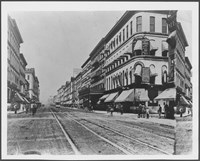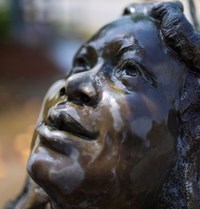- Lesson Plan (12)
- Field Trips (2)
- Distance Learning (1)
- Student Activities (1)
- Teacher Reference Materials (1)
- Everglades National Park (2)
- Florissant Fossil Beds National Monument (2)
- Agate Fossil Beds National Monument (1)
- Arches National Park (1)
- Canyonlands National Park (1)
- Eisenhower National Historic Site (1)
- Fort Necessity National Battlefield (1)
- Gateway Arch National Park (1)
- Glacier National Park (1)
- Show More ...
- Science (11)
- Social Studies (8)
- Literacy and Language Arts (5)
- Math (1)
- 11-12.RH.4 (1)
- 11-12.RL.4 (1)
- 3.L.1 (1)
- 3.L.5 (1)
- 3.RF.3 (1)
- 3.RF.3.a (1)
- 3.RF.3.b (1)
- 3.RF.3.c (1)
- 3.RF.4 (1)
- Show More ...
Showing 17 results for carbon dioxide ...
Carbon Cycle Capers
- Type: Lesson Plan
- Grade Levels: Upper Elementary: Third Grade through Fifth Grade
"The Carbon Budget" Climate Change: 4-6th Grade
- Type: Lesson Plan
- Grade Levels: Upper Elementary: Third Grade through Fifth Grade

Students use math, visual and auditory techniques to demonstrate that the amount of carbon being added to the atmosphere by humans is more than what the planet is removing. This activity can use different learning styles to demonstrate the 2008 global carbon budget. Show that the imbalance of a yearly extra four billion tons of carbon dioxide in the atmosphere is the fundamental cause of climate change.
"Algae: It Feeds, Kills and Dies" Plant Activities: 4-6th Grade
- Type: Lesson Plan
- Grade Levels: Upper Elementary: Third Grade through Fifth Grade

Our "Plant" unit is broken into six lesson plans, each taking from 20 minutes to several class periods to complete, and targeted mainly at 4th-6th grade students. A class needn't complete every lesson in the unit, though some lessons do refer to one another and are better done in sequence. However, each lesson comes with its own set of objectives and resources.
Coral Reefs: Ecosystems Dissolving
- Type: Lesson Plan
- Grade Levels: Middle School: Sixth Grade through Eighth Grade

Corals face in our modern world, a great threat due to a projected change in water chemistry in the ocean due to global warming. Just as carbon dioxide (the main greenhouse gas causing global warming) is increasing in the air, it also increases in seawater in its dissolved form. That makes seawater more acidic which, in turn, may slow the rate at which corals build their calcium carbonate skeletons.
Make Your Own Fossils
- Type: Lesson Plan
- Grade Levels: Upper Elementary: Third Grade through Fifth Grade
Cave Cracks
- Type: Student Activities
- Grade Levels: Middle School: Sixth Grade through Eighth Grade
A "cool" demonstration using a block of ice to simulate carbonic acid dissolving away a cave.
- Type: Field Trips
- Grade Levels: Upper Elementary: Third Grade through Fifth Grade
Climate Change Scavenger Hunt
- Type: Lesson Plan
- Grade Levels: Upper Elementary: Third Grade through Fifth Grade
Climate Change in Vermont: Measuring Predicted Impacts
- Type: Lesson Plan
- Grade Levels: High School: Ninth Grade through Twelfth Grade

In the "Emerging Science" episode (VT Public Television) “Climate Change: A Northeast Primer,” students are introduced to present-day and potential future impacts of climate change on Vermont. Through these activities, students plan ways to measure climate change, explore climate change data, and use phenology to detect a species’ response to climate change.
LESSON 11: OD POR ODELIA
- Type: Lesson Plan
- Grade Levels: High School: Ninth Grade through Twelfth Grade
Od Por Odelia was written by LeRoy Etienne as an ode to his mother who told him this story. In the tale an old man sells her rotten bananas. But dishonest conduct brings bad luck, and the old man dies soon thereafter.
- Type: Lesson Plan
- Grade Levels: Middle School: Sixth Grade through Eighth Grade
Traveling the National Road: Unit 6 Decline and Rebirth of the National Road
- Type: Lesson Plan
- Grade Levels: Upper Elementary: Third Grade through Fifth Grade

This unit covers the decline and rebirth the National Road, teaching the students about how railroads ended the National Road and how bicycles and cars helped it come back. It includes background information for the teacher, a student reading and two student activities: A Poem and a Riddle About the National Road and Picture Matching on the National Road.
Tort Liability: Franke v. City of St. Louis
- Type: Field Trips
- Grade Levels: Upper Elementary: Third Grade through Fifth Grade

Frederick Franke was injured in St. Louis when part of a building fell on his head as he was walking. Tragically, he died as a result of his injuries. His mother, Julia Franke, sued the owner of the building and the City of St. Louis for damages. This case was heard in 1888 in the St. Louis Courthouse (the Old Courthouse). Students will reenact the case and hear from all sides.
Death Traps
- Type: Teacher Reference Materials
- Grade Levels: Middle School: Sixth Grade through Eighth Grade

This scripted slideshow for teachers describes the process by which animals have died and become fossilized in waterholes, influenced by a severe drought. It compares two sites, separated by 13 million years: Agate Fossil Beds and the Badlands. It is designed to teach students the principles relating to the behavior, habitat and survival of living animals; as well as scientific study of past life forms known as fossils; and severe climatic events.
Ike and the Men of D-Day (Virtual Program)
- Type: Distance Learning
- Grade Levels: High School: Ninth Grade through Twelfth Grade

Explore the "Great Crusade" with General Eisenhower and the Men of D-Day in this virtual education program. Students will discover the events of D-Day through the leadership principles of General Eisenhower and the sacrifices of real soldiers who fought and died on D-Day. This program gives students a chance to examine primary source documents and research real D-Day casualties who are buried in Gettysburg National Cemetery.







